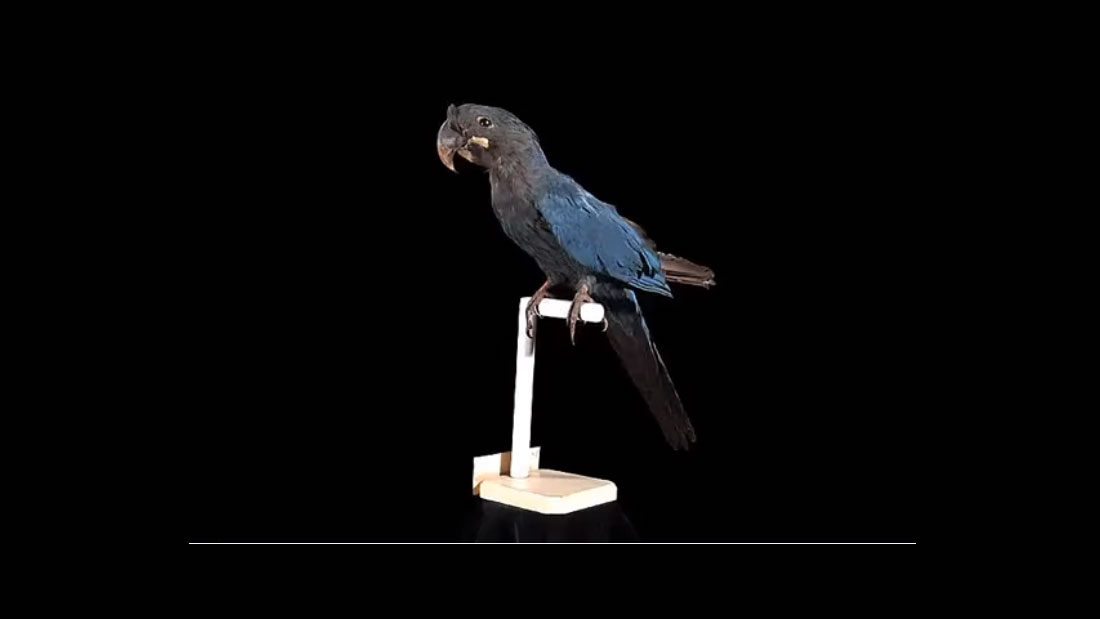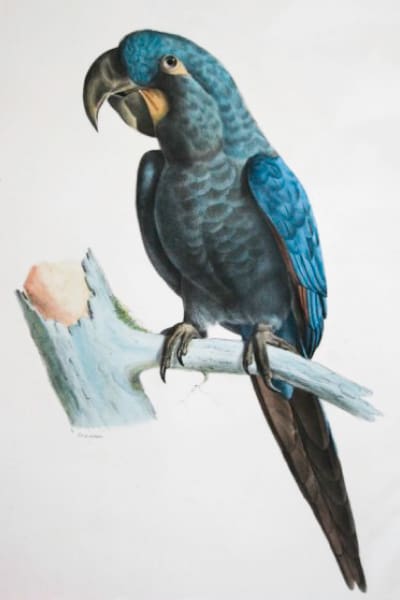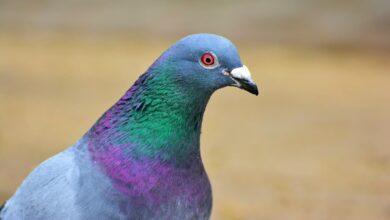Glaucous Macaws (Guaa-Obi) – Facts, Diet, Habitat & Threats
The Glaucous Macaw (Anodorhynchus glaucus) is a large, pale-blue parrot that is native to South America and Central America. The bird is a member of the Psittacidae family. All macaws are parrots – you knew that! – But not all parrots are macaws.
Table of Contents
The subspecies that inhabited the river basins of northern Argentina, southern Brazil, Paraguay, and Uruguay became critically endangered and probably extinct. It has turquoise plumage, a dark beak, and hauntingly beautiful vocalizations – referred to as “guaa-obi” in Guaraní. It’s a wetland habitat that has enchanted conservationists and ornithologists for more than a century.
Quick Information on Glaucous Macaws
- Class: Aves
- Phylum: Chordata
- Kingdom: Animalia
- Family: Psittacidae
- Genus: Anodorhynchus
- Order: Psittaciformes
- Species: A.glaucus
- Body length: 70 centimeters (26 inches) long
- Distribution: Middle reaches of the major rivers (Uruguay, Paraná, and Paraguay) and adjacent areas, with most records coming from Corrientes, Argentina
- IUCN conservation status: Critically endangered
Scientific Classification
The kingdom of Glaucous macaw is ‘Animalia’ with the genus, ‘Oncorhynchus.’ Adding to it, the Glaucous macaw is categorize in the class Aves. It is also placed in the order ‘Psittaciformes’ and the family ‘Psittacidae.’
| Classification Level | Detail |
|---|---|
| Kingdom | Animalia |
| Phylum | Chordata |
| Class | Aves |
| Order | Psittaciformes |
| Family | Psittacidae |
| Genus | Anodorhynchus |
| Species | A. glaucus |
| IUCN Status | Critically Endangered (Possibly Extinct) |
All You Need to Know About Guaa-Obi!

Appearance
The Glaucous Macaw is a large, predominantly turquoise-blue macaw with a greyish head. Upper tail feathers are blue/green, while the inner tail surfaces appear gray. The beak is blackish grey, and the facial skin is yellow, paler than the peri-ophthalmic area. Its eyes are dark brown, and its legs are dark gray to black.
Vocalizations
In the Guaraní language, the Glaucous Macaw was refer to as “guaa-obi” from the distinct, unique calls of its wild presence in the fluvial forests of South America. Their calls were loud, resonant croaks, which they would make and repeat in patterns. These calls are to communicate amongst flock members, in particular, to maintain contact to avoid collisions in thick palm-forest foliage or flights.
As with other macaws, they could exhibit a high level of vocal mimicry while in captivity, based on a small amount of data produced. Their call may have been important in marking territory and getting mates.
Behavior and Intelligence
The critically endangered Glaucous Macaw was recognized as an intelligent species of social birds with excellent cognitive skills. Unlike all large macaws, they play with objects using their beak and feet, vocal mimicry, and pair-bond formation. These birds were highly social and needed tremendous mental and physical stimulus.
Now it appears that these animals roamed in pairs or small clusters across the wild and they might even have roosted together. These animals could solve elementary tasks and react to human gestures. But when understimulated or left alone, macaws commonly develop characteristics such as feather plucking, aggression, and loud vocalizations.
Distribution
Anodorhynchus glaucus was widespread in the past but clearly local in north Argentina, south Paraguay, north-east Uruguay, and Brazil from Paraná state southwards. Early in the 19th century, it became rare and there were only two acceptable records in the 20th century.
One direct observation was made (in Uruguay in 1951) and one based on local reports (in Paraná in the early 1960s). Persistent rumors of recent sightings by local reports and birds in trade indicate that a few birds may still survive, but it has been generally treated as extinct which is heartbreaking!
Social Behavior
Glaucous Macaws are monogamous, bonding for life like other macaws in their genus. Such couples groomed each other, nested cooperatively and raised the chicks together. In groups, they may have joined in social dominance hierarchies or ganged up on military tactics in defense of food sites or nesting places.
Socializing between these individuals must have been fraught with vocal and visual conversation. Vocal duetting, synchronous calls, and communal alert responses indicate a highly complex, cooperative social system.
Captivity and Pet Trade
In the past, there were extremely small numbers (if any) of Glaucous Macaws in captivity. Those were likely suffering from the species-specific knowledge at the time. Some captive macaws include one shown at the Buenos Aires Zoological Gardens in 1936 and another that lived in Paris from 1895 to 1905.
Related Pick: Macaw as a Pet – Everything You Need to Know!
These birds may not have bred successfully in captivity because of stress, poor diet, or inadequate stimulation. Their beauty, however, has ultimately made them a sought-after species in the pet trade. Due to their rarity and high price, people trap them illegally, causing a further decline in the wild population.
Despite their gentle nature, Glaucous Macaws would have needed vast amounts of space, specialized food, and rich entertainment that only their natural environment or elite keepers could give them. Today, their appearance in the pet trade raises ethical issues and conservation consciousness.
Historical Distribution
The historic range of the Glaucous Macaw is the central portions of the Paraná, Paraguay, and Uruguay Basin, predominantly throughout northeastern Argentina (notably Corrientes). But also exists in southern Brazil, Paraguay, and Uruguay. By the mid-20th century, they had declined to near extinction, with the last accepted sighting in Uruguay in 1951.
| Region | Notes |
|---|---|
| Northeastern Argentina | Most sightings from Corrientes |
| Southern Brazil | Paraná state southwards |
| Paraguay | Once locally present |
| Uruguay | Confirmed sighting in 1951 |
Lifespan
Big macaws supposedly live between 50 to 80 years if they live in the perfect world. Nevertheless, Glaucous Macaws that have been kept in captivity have lived for between 14.8 and over 20 years, so one has relatively little data on this species. Stress, dietary parasites, and other diseases kept in captivity probably reduced their expected lifespan.
| Environment | Lifespan |
|---|---|
| Wild (unknown) | Estimated 40–60 years |
| Captivity | 14.8 to 20+ years |
Diet
Glaucous Macaws were dietary specialist, being highly dependent on palm nuts from the Yatay palm (Butia yatay), which once thrived in their native habitats, and served as a primary source of food for macaws. They would also have eaten a wide range of fruits, seeds, nuts, berries, and other plant foods. Seasonal differences in fruit availability likely influenced their movement patterns.
| Food Type | Specific Example |
|---|---|
| Palm Nuts | Yatay Palm (Butia yatay) |
| Fruits | Ripe and unripe local wild fruits |
| Nuts/Seeds | Forest nuts, likely seasonal |
| Vegetation | Berries and leafy plant matter |
Reproduction
Though the data is scarce, they likely lives on steep slopes or cliffs, and some rare sightings of large tree cavities are also in records. As with most macaws, the expected clutch size is approximately two eggs per breeding season. They probably had an incubation period of about 26 to 28 days, and the chicks would be taken care of by both parents.
| Reproductive Trait | Details |
|---|---|
| Nesting Site | Cliff faces, rarely tree cavities |
| Clutch Size | Usually 2 eggs |
| Incubation Period | Estimated 26–28 days |
| Parental Involvement | Both parents |
Price
Glaucous macaws cost you around $850 to $15,000.
Health Concerns (in Captivity)
Although there were very few captives of Glaucous macaws, they probably were as susceptible to the same diseases as Other macaws:
- Avian flu
- Parasites (internal and external)
- Psittacine Beak and Feather Disease (PBFD)
- Egg binding in females
- Stress-induced immunosuppression
Preventive care, proper diet, and environmental enrichment are crucial to managing the health of the captive macaw. The absence of these factors probably accounted for the shortness of life in the few Glaucous Macaws held in zoos or private collections.
Threats to the Glaucous Macaw
The major river basins in which Glaucous macaws were settled were accompanied by the loss of palm groves, either through direct clearance for agriculture or the subduing by colonists’ cattle. Yatay palm, on which the species probably fed, was targeted for clearance by early colonists as it is an indicator of good soil quality.
Comparatively, the size and appearance of the bird made it a significant target for hunters and were used as pet trade. Apart from forestry, farming, and ranching, there is also an enormous hydroelectric complex at Salto Grande on the River Uruguay, which has resulted in the flooding of lowland areas. There is some evidence that was sold, but very little to support the claims that there has been a recent trade of live specimens.
Conservation Actions
Underway
Under Brazilian law, CITES Appendix I has tried to protect them, and there have been various attempts (unsuccessful) to rediscover the species. Many ongoing funding proposals as an attempt to finance a program of work aim to confirm the presence of Glaucous macaw in the wild.
Proposed
Conduct interviews with local people, especially former and active parrot trappers, to assess the likelihood that any populations remain and are following up on any positive data from these interviews.
Causes for their Extinction

The main reason for their decline is the widespread loss of palm groves. However, suitable habitat remains in El Palmar National Park in the Argentine province of Entre Ríos, where some could have survived, but persistent rumors of their existence still exist.
Other contributing factors for the decline of their numbers in the 19th century are to be the following:
- Major river basins were settled within its range
- Their habitat underwent drastic changes due to land reclamation over the last century
- Hunting for their feathers and flesh for food
- Trapping for trading eggs, skins, or live specimens
- Possible disease outbreak
- Predation
- Loss of palm groves
Last known Specimens
The last specimen had been seen alive in Brazil, which was exhibited in the Buenos Aires Zoological Gardens (Orfila) in 1936. Additionally, another live specimen was at the Jardin d’Acclimatation in Paris from 1895 to 1905 by Jean Delacour.
The skin of one Glaucous was collected on the Rio de la Plata and from Brazil, a skeleton was collected in 1865 by Hermanus Hendricus der Meer.
Threats and Causes of Decline
The decline of the Glaucous Macaw has multiple threats that overlap:
- Loss of natural habitats, especially the removal of Yatay palm groves by agriculture and cattle pasture
- Flooding by major hydroelectric projects (such as Salto Grande on the River Uruguay)
- Captured for the pet trade, due to their size and beauty
- Hunting for feathers, food, and specimens
- Habitat fragmentation and land reclamation
- Possible disease outbreaks and predation
These pressures reduced available habitat, food supplies, and safe nesting sites, driving the species to the brink of extinction.
Last Known Sightings
- A single specimen, caged at the Buenos Aires Zoological Gardens in 1936
- A captive bird kept at the Jardin d’Acclimatation, Paris, France (1895 – 1905)
- A skin collected from the Rio de la Plata, and a skeleton collected from Brazil in 1865
Possible sightings occurred in Paraná, Brazil, possibly in the early 1960s, according to locals, but the possibility of these claims cannot be confirmed.
Conservation Efforts
Ongoing Actions:
- Legal protection under CITES Appendix I
- Field investigations, including a major 1999 expedition by the World Parrot Trust
Proposed Actions:
- Interview with locals and ex-parrot trappers
- Survey remote regions with potential remnant habitat (e.g., El Palmar National Park, Argentina)
- Follow up on local reports of possible sightings
No populations have been verified rediscovered but continued rumors and sporadic reports leave the possibility open.
Efforts Made to Save the Glaucous Macaw
Project progress
In 1999, the World Parrot Trust sent a group of 4 people including Dr. Charles Munn, Carlos Yamashita, Richard Hartley, and Alfredo Begazo to survey the historical territory of Glaucous Macaw (Anodorhynchus glaucus) in Brazil. On the whole, the search found no birds in any of the areas surveyed.
Outcome
As well as confirming the loss of the Glaucous, the census was invaluable in producing expert and original information from Ph.D. ornithologists. This information on habitat loss, trapping for the pet trade, and other issues, will assist the conservation of other species of macaws also.
Conclusion
The Glaucous Macaw represents, on one hand, a symbol of extinction and, on the other, a poignant symbol of untamed mystery. Gone, though the shimmer of its blue feathers and soulful call remain as an inspiration for global conservation. Its tale serves as a reminder that action has to lead the way to absence, and every species, however distant or rare, should get the fighting chance it deserves.
Related Pick: How to Teach Your Macaw to Talk?
Featured Image Courtesy: Wikimedia

